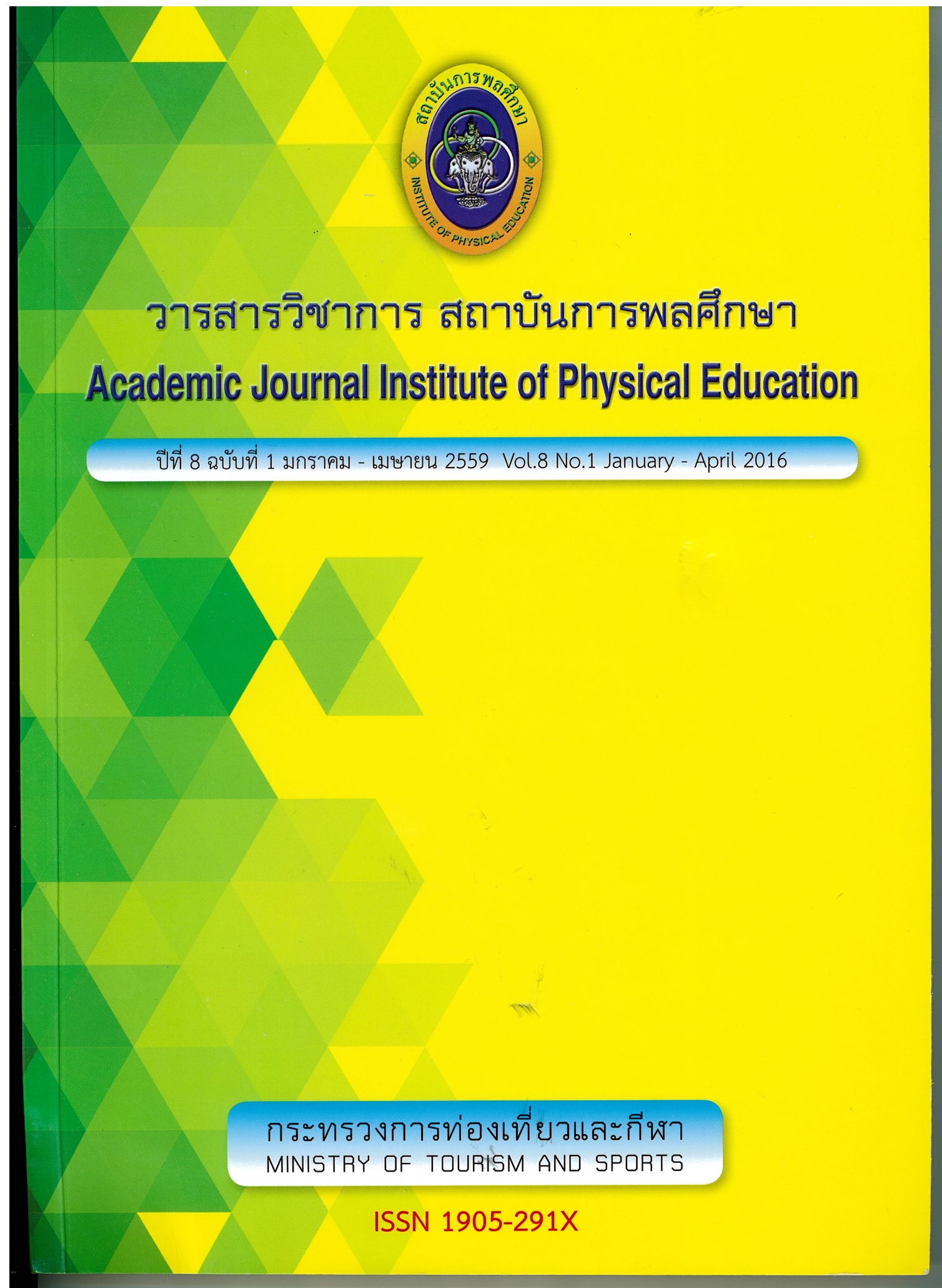Development of Muay Thai Teaching Model
Main Article Content
Abstract
The purpose of this research was to develop teaching Muay Thai model for preservation in Muay Thai course 1 for the first year students. The samples used in this research were 25 Muay Thai teachers teaching sport School, 40 Muay Thai instructors in physical Education Institute, 100 teachers teaching Muay Thai in the Provincial Arts of Muay Thai Preservation Center under Arts of Muay Thai Preservation Institute, Department of Physical Education, the Ministry of Tourism and Sports, 2 instructors teaching Muay Thai at the College of Muay
ai Education and Rajabhat University and 40 students at Physical Education Institute, Maha Sarakam campus. The samples were purposive and simple random sampling.
The instrument used in this research was consisted of Muay Thai Teaching document for preservation, lesson plans, interview form, evaluation forms on Muay Thai Teaching Model for Preservation, learning behaviors, preservation behaviors, Muay Thai skills for preservation, knowledge and understanding assessment form and attitude measurement towards the usage of Muay Thai teaching model for preservation. The statistics for data analysis were percentage, mean, standard deviation and t-test.
The research findings were as follows:
- The comparative achievement for both pretest and posttest of using the Muay Thai teaching model for preservation revealed the posttest was significantly higher than the pretest at .01 level.
- There were 80 students having positive learning behaviors and passing the evaluation criteria individually 80%.
- The students' behaviors on the arts of Muay Thai preservation were overall in high level (90.18%) higher than the required criteria (80%)
- The students' Muay Thai skills on preservation were overall in high level (89.77%) and passing the required evaluation criteria individually (80).
- The students' attitudes towards learning organization according to Muay Thai teaching model for preservation were overall and individually in high level.
Article Details

This work is licensed under a Creative Commons Attribution-NonCommercial-NoDerivatives 4.0 International License.
The published article is a copyright of the Academic Journal of Thailand National Sports University. The passage appeared in each article in this academic journal is a perspective of each author which is not related to the journal. Each author is required to be responsible for all components of his/her own article. If there are any mistakes, each author must be responsible for those mistakes on his/her own.
References
กรมส่งเสริมวัฒนธรรม กระทรวงวัฒนธรรม. (2555). ไทยไฟท์คาดเชือก (ออนไลน์), แหล่งที่มา : tvshow.tlcthai.com/category/รายการทีวี-ช่อง-3/ไทยไฟท์-thai./2/.16 ธันวาคม 2555.
กรมส่งเสริมวัฒนธรรม กระทรวงวัฒนธรรม. (2556), มรดกภูมิปัญญาทางวัฒนธรรม (ออนไลน์), แหล่งที่มา : http://www.culture.go.th/ichthailand/post.html. 1 ธันวาคม 2555
กาญจนา วัธนาสุนทร. (2550), การออกแบบวิจัยเพื่อพัฒนารูปแบบ. วิทยานิพนธ์ครุศาสตรดุษฎีบัณฑิต สาขาวิชาการวัดและประเมินผล บัณฑิตวิทยาลัย จุฬาลงกรณ์มหาวิทยาลัย, 11.
คณะกรรมาธิการการกีฬาสภาผู้แทนราษฎร สํานักงานเลขาธิการสภาผู้แทนราษฎร. (2546) แผนยุทธศาสตร์พัฒนามวยไทยสู่ระดับสากล, กรุงเทพ : สํานักการพิมพ์, 3.
ชาญณรงค์ สุหงษา. (2545). คู่มือการสอนมวยไทยเบื้องต้น. กรุงเทพมหานคร: บรรณกิจ, 2.
ทิศนา แขมมณี. (2552), ศาสตร์การสอน : องค์ความรู้เพื่อการจัดกระบวนการเรียนรู้ที่มีประสิทธิภาพ. (พิมพ์ครั้งที่ 9). กรุงเทพมหานคร: จุฬาลงกรณ์มหาวิทยาลัย, 282-284.
นิพิฏฐ์ อินทรสมบัติ. (2553), มวยไทย, สํานักงานคณะกรรมการวัฒนธรรมแห่งชาติ, กรุงเทพมหานคร คํานิยม.
ปัญญา ไกรทัศน์. (2524), ยอดศิลปะการต่อสู้, กรุงเทพมหานคร : บพิธการพิมพ์, 15.
โพธิ์สวัสดิ์ แสงสว่าง. (2522), พัฒนาการกีฬามวยไทย. วิทยานิพนธ์ครุศาสตรมหาบัณฑิต สาขาวิชาพลศึกษา บัณฑิตวิทยาลัย จุฬาลงกรณ์มหาวิทยาลัย, 25.
มหาวิทยาลัยราชภัฏหมู่บ้านจอมบึง. (2550). หลักสูตรศิลปศาสตรดุษฎีบัณฑิต สาขาวิชามวยไทยศึกษา (หลักสูตรใหม่ พ.ศ. 2550). ราชบุรี, 2-3.
ลือชา สุบรรณพงษ์. (2527), กติกามวยไทยและมวยสากล, กรุงเทพมหานคร : สารมวลชน, 2.
วัลลภิศร์ สดประเสริฐ. (2547). มวยสยาม. กรุงเทพมหานคร : เคล็ดไทย, 13.
วิชิต ชี้เชิญ. (2553). ภูมิปัญญากีฬาไทย : MORE THAN SPORT. กรุงเทพฯ: สํานักงานกองทุนสนับสนุนการสร้างเสริมสุขภาพ (สสส.), 1.
วีระ อําพันสุข. (2526), กรุงศรีอยุธยา, กรุงเทพมหานคร : คุรุสภาลาดพร้าว, 162.
สมชาย เสียงหลาย. (2553) มวยไทย. กรุงเทพมหานคร : สํานักงานคณะกรรมการวัฒนธรรมแห่งชาติ,
คํานํา สมศักดิ์ ศิริอนันต์. (2541). กรุงเทพมหานคร : ศิลปะมวยไทยชั้นสูง. กรมศาสนา, 5-6.
แสวง ศิริไปล์. (2520), เอกสารประกอบการเรียนมวยสากล, มหาวิทยาลัยศรีนครินทรวิโรฒ, กรุงเทพมหานคร, 1.
Batten, G. D. (1999). Senescence of the flag leaf and grain yield following late foliar and root applications of phosphate on plants of differing phosphorus status. Journal of Plant Nutrition, 10, 735-748.
Beat, J. W. (1981). Research in Education. New Jersey : Prentice Hall,
Engle Bigge, M. & Samuel, S. (1992). Learning Theories for Feachers (5th ed). New York: Harper Collins.
Brookfield, S. D. (1987). Developing Critical Thinkers: Challenging adults to explore alternative ways of thinking and acting. San Francisco: Jossey-Bass.
Gagne, R. M. (1977). Condition for Learning. Library of Congress Cataloging in Publication Data. Holt, Rinehart and Winston.
Glogower, N. (2009). A good defense will leave you beautiful, a bad defense will make you ugly: Gender in Muay Thai kickboxing. M.A. dissertation, Michigan State University, United States Michigan. Retrieved September 15, 2010, from Dissertations & Theses:
A&I.(Publication No. AAT 1478803).
Kindleberger, C. P. (1998). American Business Abroad: Six lecture on direct investment. New Haven: Yale university Press.
Phonglorpisit, S. (2003). The effect of strapping on changing the velocity of punching and kicking in Muay Thai boxer. The Degree of Master of Science (Sports Science), Mahidol University.
Sangperm, P. (2003). Practice and nutrient intake for weight reduction during the last 3 days prior to the competition in Thai boxers. The Degree of Master of Science (Sports Science), Mahidol University.
Schissel, P. (2008). Muai Thai and the embodiment of fighting forms in a rural, northeast Thai household. M.A. dissertation, Carleton University (Canada), Canada. Retrieved September 15, 2010, from Dissertations & Theses: A&l. (Publication No.AAT MR 40611).
Sports Focus. (2004). Muay Thai, a national tradition. RBSC Magazine 4(42) December 2004.
Hoogvelt, A. (2001). The Third World in Global Development. London: Macmillan Publishers Ltd.
Weinstein, M. (1991). Critical thinking and education for democracy. Resource Publication Series 4. No.2.
Yamane, T. (1967). An Introductory Analysis. New York: Harper and Row.


